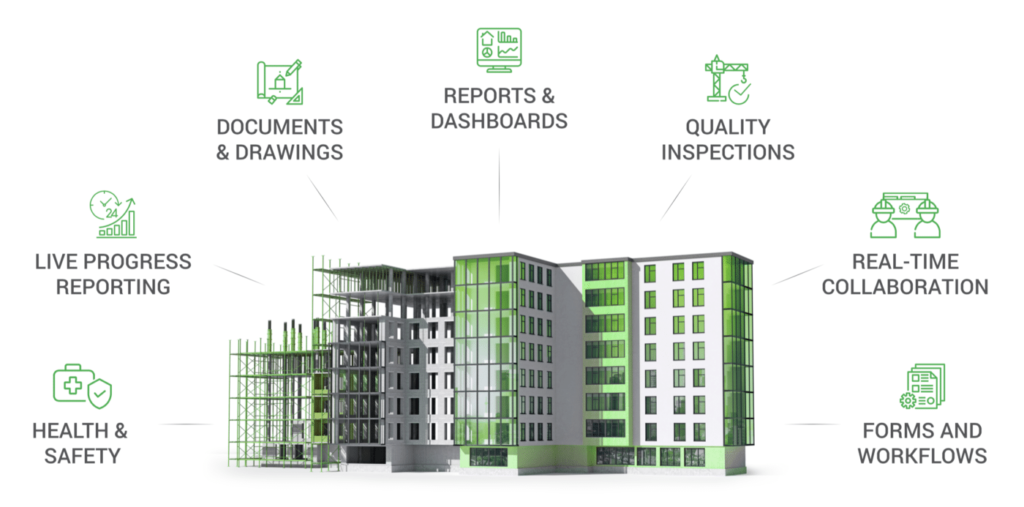What is BIM software?
That’s a question that lately is attracting more and more attention within the construction industry. Interestingly enough, there are many different answers to it. The truth is that Building Information Modeling is much more than a software solution, as it touches upon the way you organise your workflows, collaborate and interact with other project stakeholders.
In that sense, even if BIM is primarily promoted as a 3D model it covers a much wider spectrum of activities all relying on the unique value of the captured data. However, when it comes to BIM software the confusion is still there. To some extent, this has also to do with the fact that BIM has evolved a lot in the course of the last few years.
The big misconception, though, that BIM is only about the 3D model is still here. That is considered normal by many in the sector as it is easier to promote BIM as 3D modeling software than as a working process. After all, a user can’t buy the workflow. They have to set it up and roll it out across the entire organisation with the help of an open data ecosystem.
With that in mind, it becomes clear that the success of implementing and managing BIM in your organisation goes hand in hand with reinventing both your internal and external systems and processes.
We are referring to a major paradigm shift that requires a lot of work, brave initiatives and continuous effort to educate your team on the ways in which Building Information Modeling can improve their daily working routine and remove their admin and mental burden.
BIM to manage information
It goes without saying that data is at the core of this process. User adoption on-site will pave the way for a BIM-driven construction process where different stakeholders share their data and act on it in real-time.
That’s extremely important considering the overall context of the construction industry around data. In a period where the amount of collected information is increasing at an exponential pace, managing these high volumes of data has become extremely challenging.
This may put many construction projects in danger as the effective management of the captured information isn’t always possible leading to serious project losses, construction delays, and budget overruns.
It doesn’t take much to understand how big of a problem that can be given that every single task in construction heavily relies on information collected on the field.
This is where Building Information Modeling comes into play. BIM can truly transform the information management process in a number of ways by functioning as a single source of truth that can be accessed by all stakeholders throughout the project lifecycle. This source of truth consists of a plethora of information types such as BIM models, drawings, specifications and many more.
Last but not least, setting up specific protocols can play a decisive role in ensuring that the information is managed correctly during all project phases.
Why standard internal classifications matter
Coming up with a standardised specification protocol for on-site follow up can really make a difference on your data management processes. Every organisation that starts its BIM journey needs to structure its data in an effective way.
Structured data will reduce the complexity and make these vast amounts of information more manageable for the users. In that aspect, classification systems can pave the way for more efficient communication and allow better data processing as well as improved business intelligence.
Of course, defining this protocol goes hand in hand with the standardisation of your systems and processes. Every class of objects will be combined with a specific quality check that needs to be conducted across all projects.
So next time the field team will need to check if the doors in a building have been placed correctly, they can just go back to the protocol and see what’s the right way to go about it.
“What we are really hard working on is making sure that everything that has been done during the previous stage can be reused afterward,” explains Juan Nolet, BIM Manager at Besix.
That’s extremely helpful if we consider that most construction companies work simultaneously on a number of projects. In many cases, this means that they have different types of classifications, too. What they need, though, is a unified protocol containing a certain set of standard internal classifications so they can link their ERP system to them.
By mapping BIM object classes to specific planned tasks, checklists, forms and teams you ensure that processes are standardised and automated to ease the workflows on site. For instance, the Health and Safety flow will be defined in the beginning and run automatically to the entire project. And with every task completed and check performed field data flows back to the BIM model.
With that in mind, it becomes clear that construction companies need a platform that will function as a flexible gateway for BIM processes from one project to another.
How BIM software can boost construction efficiency
By now it becomes clear that Building Information Modeling can have a transformative effect on construction and introduce higher standards of productivity.
This radical change is the result of working on a Common Data Environment (CDE) where all project participants can deposit their data and collaborate better. The increased visibility across the supply chain can lock misunderstandings out of the building process and increase operational efficiency.
In brief, here are a few of the ways BIM can improve construction efficiency:
Clash detection
The automation of the clash detection process can save your project both money and time. The virtual representation of the built structure allows project agents to remain one step ahead and prevent design conflicts before they emerge on site.
Thanks to Building Information Modeling, the resolution of design clashes and constructability issues can happen at an early stage and minimise the impact of a potential change on the project’s design and plan.
![]()
Information management
We have already referred to the importance of a Common Data Environment (CDE) and the value that it could bring to the management of a construction project. A BIM model contains a massive number of data as well as crucial information about every single area of the construction process ( eg. materials, furniture, mechanical equipment, etc).
“There is a huge information need on construction site about what they have to build and what is a result you’re working to. And so we would like to give an answer to that information need. And I think that’s BIM, BIM models. And it is a good solution for that. It’s, on the one hand, visual, strong product that people can see what they have to construct,” suggests Dieter Froyen, BIM Manager at Willemen.
And he adds:
“But it also gives all the information they need about the product performances, and material, and quantities. All that information need is answered by a good BIM model.”
Thanks to BIM, all these precious bits of information can be stored in one place and remain accessible by all the involved parties. This element establishes a communication flow between the different project agents and protects the building process from costly misunderstandings and schedule delays.
At this point, it becomes also evident that data hold a much more prominent role than the 3D geometry because of their value at various stages of the building life cycle.
4D time management
The fourth dimension of BIM is also known as construction sequencing. In general, it refers to the enrichment of the information model of a project with an additional row of scheduling data. In that way, stakeholders both in the office and the site can have a precise overview across tasks while staying one step ahead of any issues that could emerge.
In other words, 4D BIM facilitates the visualisation of each project stage and makes sure that construction activities are planned better.
The rise of 4D BIM should not be seen as a way to replace planners. To the contrary, they are still a decisive component of the project. The only difference is that now they can complete their job faster and with higher accuracy.
5D cost management
The fifth dimension of BIM is dedicated to cost management. 5D makes it possible for project agents to work in a centralised data environment from day one. This new working approach eliminates the possibility of having people working in an isolated environment and prevents misunderstandings and costly reworks.
5D BIM allows also the faster processing of automatically generated quantities. The connection of data with specific components within the BIM model allows estimators to improve cost control throughout the entire project. Additionally, project agents can rely on the model to continuously update cost reports as the project moves forward.
How to choose BIM Software?
But how do you choose the right BIM software for your needs?
Do you focus on specific features and custom-tailor your BIM solution to your AEC requirements? Do you leave anything out or do you need all of the aforementioned BIM functionalities? What if you don’t have in-house experts from all AEC disciplines? Do you start small and scale later?
This is a good moment to introduce BIM maturity levels.
BIM the concept revolves around the collaboration between a number of AEC professionals during a project’s lifecycle, and BIM maturity system serves to classify 4 different levels of their involvement in the project, and with that, the number of dimensions used in the process, from 3D to 8D:
- 3D (visual) – project visualization
- 4D (time) – planning and scheduling construction activities
- 5D (cost) – estimating budget and tracking costs
- 6D (operation) – operation and facility maintenance from construction to completion
- 7D (sustainability) – estimating and reducing energy consumption
- 8D (safety) – drawing emergency plans and preventing safety issues.
At the outdated BIM Level 0, the collaborative workflow practically doesn’t exist – this maturity level is essentially equated with 2D. BIM Level 1 introduces partial collaboration and allows the exchange of 2D and 3D information via an online CDE (Common Data Environment) repository.
In addition to 2D and 3D, BIM Level 3 adds 4D and 5D information, thus enabling AEC professionals from various disciplines to share common file formats and integrate their work into a unified model. However advanced, this is still not a “master” model that modern BIM aims to achieve.
The “master” model includes the remaining three dimensions as well and uses cloud computing to ensure seamless exchange, integration, and unification between different AEC disciplines. This is BIM Level 3, which is also known as Open BIM, iBIM, or the Holy Grail of the BIM concept.
In choosing BIM software, you’ll be choosing between Levels 1, 2 and 3.
Anything less than that doesn’t match the modern-day standard of BIM the concept.
The usual considerations of IT procurement, such are user experience and cost-effectiveness, won’t help you choose the best BIM software solution, and here’s why. Regardless of the level you choose, most BIM solutions are highly sophisticated, user-friendly, and beneficial to your budget.
These are the questions you need to ask instead:
- Which exchange formats are supported by BIM software?
- Which AEC features and tools does the solution include?
- How many people can work on a project at the same time?
- How many dimensions and maturity levels does it support?
Depending on your specific requirements and procurement budget, the answers to these questions should help you determine the best BIM software for your needs. By definition, it must include tools for digital construction and information management, so don’t settle for anything less.
BIM software: 3 steps to successful implementation
Once you have found the software that will help you introduce BIM to your organisation, it is time to focus on the implementation process. A common mistake we witness both in construction and other tech-related sectors is that companies try to roll out across all projects and departments from day one.
Trying to change your core systems and processes so radically in such a short time can be a disaster. That’s why it is highly recommended to put together a precise BIM implementation and management before you begin. In a nutshell, here are the three main steps you need to keep in mind
1. Focus on your problems, not on the technology
Before you fall for the “nice and shiny” elements of Building Information Modeling, it is of paramount importance to focus on the problems you want to solve instead of the digital tools per se.
In that manner, you will be able to detect the main sources of pain for your organisation, find the right software and put together a well-articulated plan of action. Simply put, before you go digital, you need to define what you are trying to solve through the digital transformation of your firm.
Find also: BIM implementation and management: Changing construction from the bottom up
After all, you should never forget that data culture is decision-making. The consistent collection and analysis of data will enable project stakeholders to make accurate and fact-based decisions leaving no room for mistakes during the building process and paving the way for positive margins.
2. Start small
The introduction of BIM software to your business should be done with baby steps. Like that, you have time to fix any transition problems that might appear without them turning into a threat for the entire organisation.
Ideally, you should start by assigning this paradigm switch to a smaller department or group of stakeholders within your company. This team should consist of both people who have a tech background and representatives of the onsite personnel. The combination of the two sides will lead to the creation of a functional workflow that encourages user adoption while pushing for a strong digital shift.
Once your designated BIM task force has completed the first roll-out wave, it is time to expand the use of the new tools to the entire organisation. That’s the first step toward standardisation.
3. Standardise
The path to digital adoption goes through standardisation. By setting a well-defined framework of action, you can ensure that the different field teams will adopt the new way of working easier and faster.
That is one of the biggest challenges the construction industry battles against as Juan Nolet explains below:
“What we are now facing is really the challenge of making people adopting the same language. So the standardisation of data is for us the core of our collaboration around BIM. If I asked somebody on site to fill in a form that has no link to a BIM model, people will not see how integrated the procedure could be. And so the approach is not really relevant. Having the forms linked to our BIM data will enable us from a BIM perspective to directly access the information that has been collected on site.”
In that aspect, the centralisation of information with the help of an intuitive, yet simple-to-use, digital tool can really make a difference.
How to train employees to use BIM software
While communicating your needs to a BIM provider, it’s not a bad idea to ask them one more question – whether or not they provide a training programme for new users. If the solution you’ve chosen is any good, it won’t be very hard to master. But BIM is still a complex concept.
The problem is, you cannot use software BIM without concept BIM. You’ll still need to set up standards for the workflows, objects, and templates you’ll be using in your projects. Without everyone from the team on the same page, you won’t be able to achieve the quick, efficient, and frictionless multidisciplinary collaboration that was promised.
That said, you should have discipline-specific content libraries with model templates set up before the training begins. This will make the system onboarding much easier, help your team get used to the new working approach quicker, and reduce the number of resources you’ll spend during training.
As for the actual training, continual learning is key. Professional associations, such as the Association of General Contractors of America, National Association of Homebuilders, and American Institute of Constructors can help you discover many authorized providers of continuing education for BIM the concept and BIM the technology.
eLearning programmes are the best option for your AEC professionals, as they improve retention rates while reducing training times to a minimum. Bing designed with employed professionals in mind, webinars and online courses allow highly personalized and self-paced learning as well.
But when it comes to your BIM software specifics, nobody can train your staff better than the people who’ve built the tools. Because of this, available training programmes and responsive technical support should be very high on your list of priorities when choosing your first BIM solution.
Why BIM engagement on the site is challenging
We have already mentioned above that the biggest roadblock for the implementation of BIM in the construction industry is found in the execution phase. That comes as no surprise considering that engaging with BIM on the field remains a big challenge for many field teams.
Below you can find some of the main reasons why this happens:
- On-site personnel has limited experience with information management processes and by extension with BIM.
- In many cases, there is a conservative culture towards digital technologies in construction. Especially on the field.
- Change management is tough at the firm/project level.
- Lack of standardisation when it comes to BIM on-site workflows and processes.
- BIM has gained more attention in the boardroom but things are still unclear on how to use it on site.
- A lot of project information is still captured and stored with pen and paper. That hinders its transition to BIM models.
What’s the best BIM software?
The best BIM software is the one that serves your project objectives well. It integrates with your existing applications seamlessly and it doesn’t require you to turn your existing workflows upside down but improves the good practices you’ve already established by bringing everyone to the same, centralized platform for designing, building, and managing.
The best BIM software ensures effortless collaboration in an open data ecosystem.
By integrating 3D modeling software with information management, it empowers your team to efficiently and effectively manage different parts of the same projects and make better decisions throughout the project lifecycle. With that, it yields the following benefits:
- Improved multidisciplinary coordination.
- Increased productivity and efficiency.
- Improved time management and faster delivery.
- Reduced risk of delays, errors, and information loss.
- Maximized quality of project deliverables.
- Reduced project costs and higher ROI.
![]()
Let’s bring BIM on the field
Finding the right BIM software solution for your organisation and by extension, your projects isn’t a walk in the park. Nevertheless, knowing the needs of your business and understanding what challenges your onsite personnel faces can help you make the right choice and prioritise user adoption.
To achieve that you need to enhance on-site processes by enabling the communication between the site and the office through BIM models. 3D can be a valuable tool in your effort to ease project understanding but it has to be combined with a standardised process of collecting, storing and analysing the data that is generated on the field.
Like that, you will be able to connect tasks and documents to BIM objects and start reaping the benefits of an open and highly collaborative data ecosystem.




